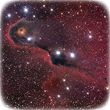The Case of the Massive Forming Star
How do massive stars form?

Disks and jets related to newly forming starsCredit: STScI, NASA
Astronomers understand a great deal about how the Sun and similarly large stars formed because there are many examples (stars like the Sun are quite common), and we can directly examine the birth sites. These are scattered throughout interstellar space and buried in clouds of gas and dust, but not so deeply that the Hubble space telescope and large telescopes on the Earth have difficulty seeing them. Low-mass or Sun-like stars form when parts of these clouds collapse due to the tug of their own gravity.
Look up at the sky, and the Sun is the brightest object you will see. But the Sun is so bright only because it is so close to us. Many stars are larger and put out more energy than the Sun. A star 10 times more massive than the Sun puts out 10,000 as much energy, and a star 100 times greater puts out 1,000,000 as much energy, yet these giants do not outshine the Sun in the sky because they lie well outside our solar system.
Massive stars are of great interest to astronomers because no one knows exactly how they form. Investigations are difficult because these stars are relatively rare and most lie at large distances from the Sun. Moreover, during their infant stages, massive stars are buried in clouds of dust and gas, as are Sun-like stars, but deeper. As a result, it is an open question whether the process of forming high-mass stars is the same as for low-mass stars. (See video of interview with Jonathan C. Tan on the left. Hover on image and click the play button.)







